

Katerina Fisher IMAT 2023 Candidate
10th of April, 2023The IMAT (International Medical Admissions Test) for the year 2021 took place on September 9th. It was originally planned to be held in several test centers around the world, including cities like Baku, New Delhi, Toronto, Tel Aviv, and more. Unfortunately, due to COVID restrictions, some of the test centers had to be canceled, including Israel, and many test-takers had to travel to Italy to take the exam. The test results were released on September 30th with only the serial number that test takers received on the test day. The public ranking with the test scores and names was released on October 7th. The EU students received updates on the rounds every week until all seats were filled in all universities, which varied in duration.
The form is A form so all answers are A
IMAT 2021 Structure
The IMAT 2021 exam consisted of 60 multiple-choice questions that are divided into four sections:
- Section 1: Logical Reasoning and General Knowledge (22 questions)
- Section 2: Biology (18 questions)
- Section 3: Chemistry (12 questions)
- Section 4: Physics and Mathematics (8 questions)
All these to be completed in 100 min.
The exam is designed to test candidates’ problem-solving abilities, knowledge in various scientific areas,general knowledge and quiet honesty,stress management abilities.
Content Quick Navigation
Grading
The IMAT exam is scored out of a maximum of 90 points, and the grading system is based on a raw score. Each correct answer is awarded 1.5 points , and -0.4 penalty is given for incorrect answers and 0 points for unanswered questions.
* If two students who took the Imat and obtain the same overall score, their scores on each section will be used to determine their ranking. In this case, the highest score in the Logical Reasoning and General Knowledge section will be given the highest importance, followed by the Biology section, Chemistry section, and finally, the Physics and Mathematics section, in that order. If the scores are still tied after considering all sections, the student who is older will be ranked higher.
The final score is used by Italian universities to rank candidates for admission to their medicine and surgery programs. The admission criteria and cutoff scores may vary from university to university and from year to year.
IMAT 2021 analysis
Logical Reasoning 2021
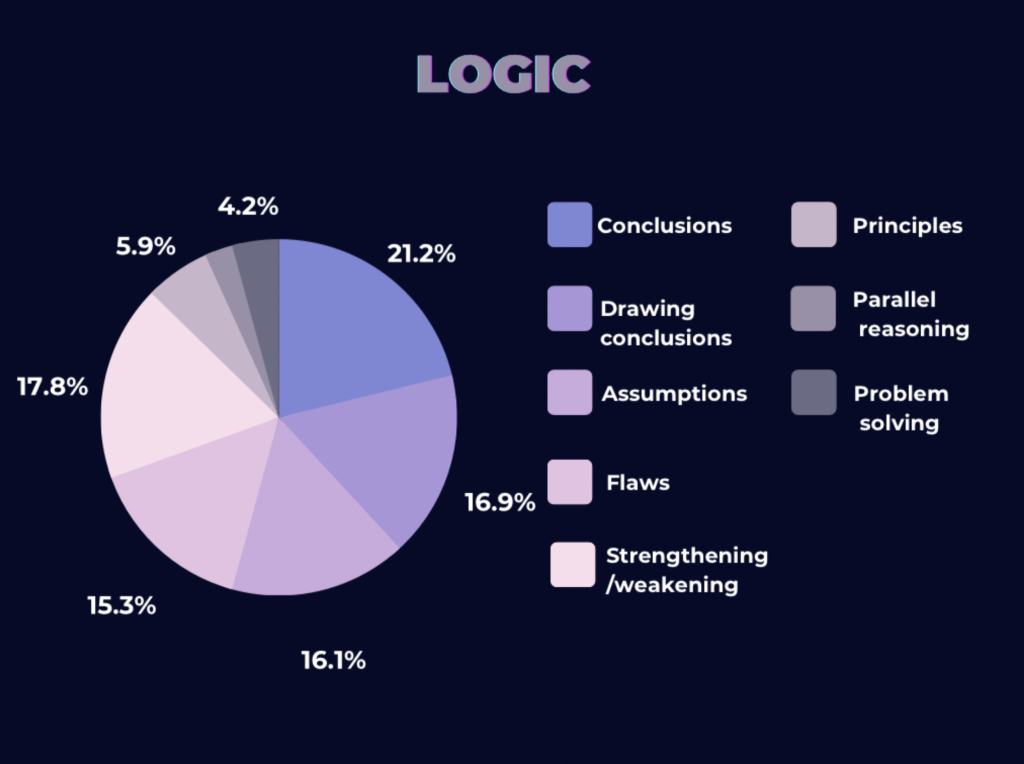

The logical reasoning section of the IMAT 2021 had the same question types as in previous years, including conclusions, drawing conclusions, parallel reasoning, strengthening and weakening arguments, principles, assumptions, and flaws in arguments.
| Type of Question | Number of Questions |
|---|---|
| Drawing Conclusions | 1 |
| Assumptions | 1 |
| Flaws | 1 |
| Parallel Reasoning | 1 |
| Principles | 1 |
| Problem Solving | 4 |
However, the questions were more scenario-based, which required test-takers to apply their logic and reasoning skills to a specific situation. The traps used in this section included confusing wording, tempting but incorrect answers, and misleading premises. Some questions used complex language or phrasing to try and trip up test-takers, while others presented answer choices that seemed plausible but were ultimately incorrect. To avoid falling into these traps, it was important to carefully read and understand each premise before selecting an answer and practicing the 7 types of questions and the methods to solve them since they are quite repetitive throughout the years just with a twist corresponding to the style of the test authors at the time .
Bellow there is an analysis of the types of questions that appear in this segment of the IMAT as of 2021
General Knowledge and Current Events
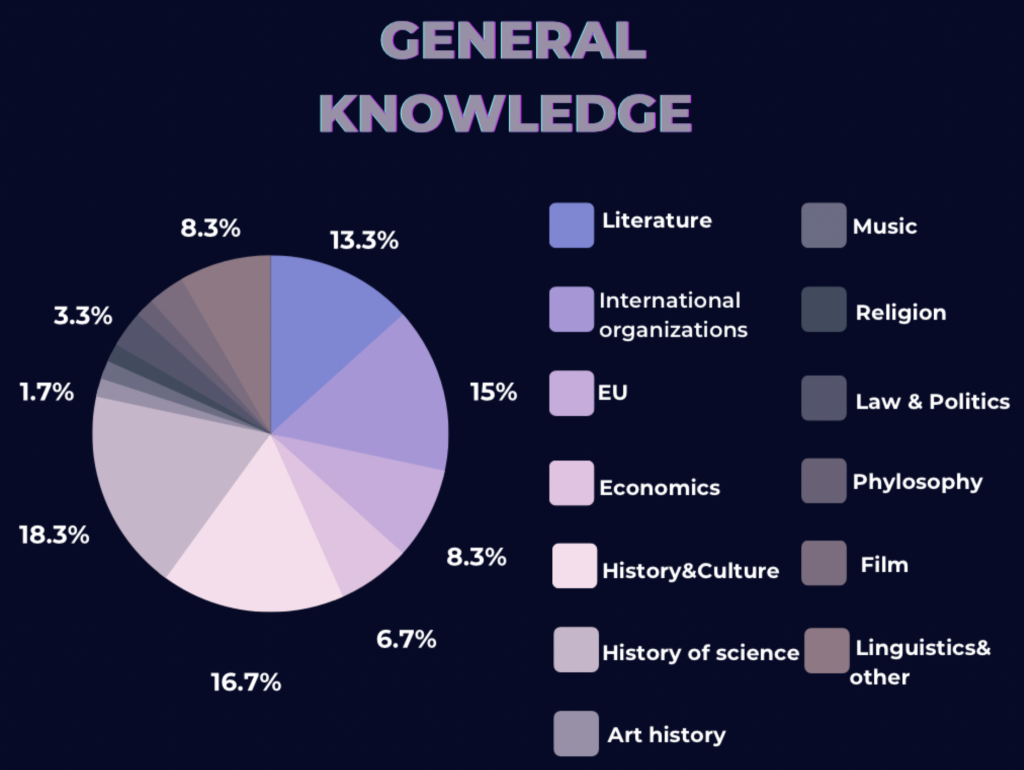

The general knowledge section of the test covered a range of topics, including history, literature, art, geography, and current events. The question types were similar to previous years, with a focus on testing test-takers’ general knowledge and critical thinking skills in combination. Some questions required test-takers to identify important historical events or figures, while others asked them to interpret a passage from a literary work or recognize great achievements in multiple fields, either scientific, politics, humanities..etc. Additionally, some questions tested their knowledge of current events and required them to stay up-to-date with the news. The questions in this section were designed to test their ability to recall important information, make connections between different subjects, and use critical thinking skills to analyze and interpret information. One of the most popular traps in this section was tricky answer choices that sounded plausible but were ultimately incorrect. Although its important, you should remember this section varies in topics and is not to be relied on for points since its almost impossible to properly study for it but its definitely possible to work on deduction skills and get some extra points !
Here’s an analysis of the various topics that were asked in past IMATs as of 2021:
| Type of Question | Number of Questions |
|---|---|
| History | 2 |
| Geography | 2 |
| Arts and Culture | 1 |
| Philosophy | 1 |
| Society and Politics | 2 |
| Science and Technology | 2 |
Biology
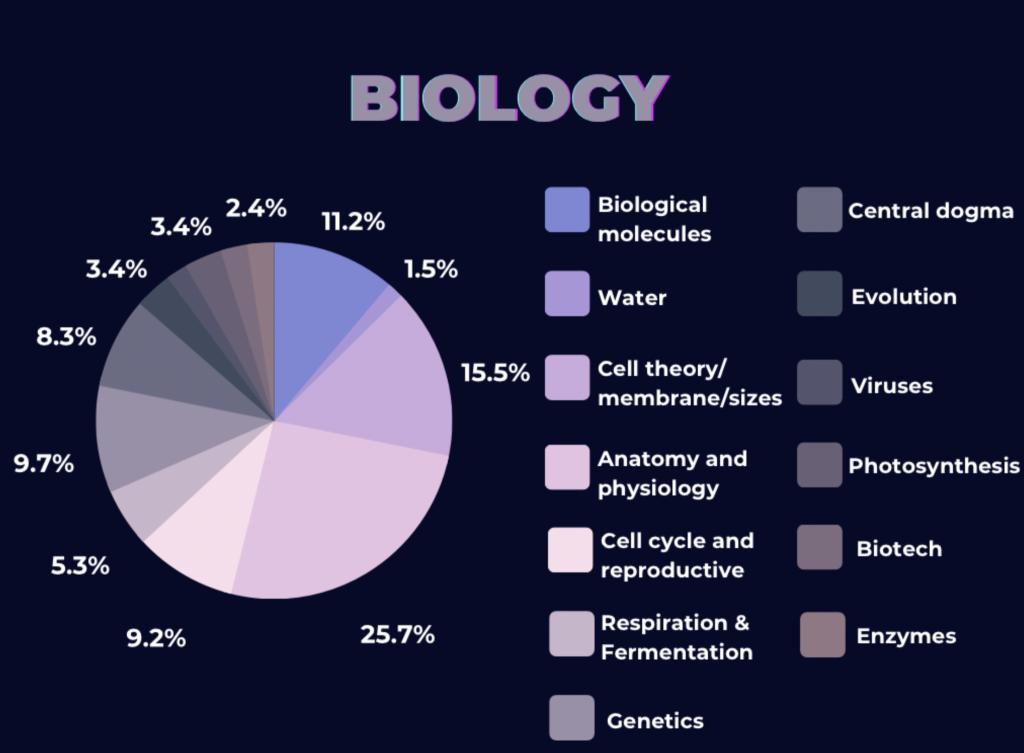

The biology section of the IMAT 2021 was notably more challenging than past years , with questions that required test-takers to apply their knowledge, rather than having the abstract knowledge and understanding of the topics at hand . The questions focused on genetics, evolution, metabolism, macromolecule’s interaction and anatomy physiology, requiring a good understanding of fundamentals and how they apply in different relating concepts and scenarios.
There were more questions that required test-takers to interpret image sets and apply this information to answer the questions at hand.
The traps used in this section included complex wording, irrelevant information, and double negatives. Some questions used technical or unfamiliar terms that could be confusing, while others included irrelevant information that could distract test-takers from the correct answer. To avoid falling into these traps, it was important to carefully read and analyze each question and use your knowledge of the topic, logic and reasoning to eliminate incorrect answer choices.
Below is an analysis of the the topics in biology that appeared in past papers as of 2021:
| Type of Question | Number of Questions |
|---|---|
| Genetics | 4 |
| Evolution | 1 |
| Anatomy/Physiology | 4 |
| Biological molecules | 2 |
| Cell cycle/reproduction | 2 |
| Enzymes | 1 |
| Photosynthesis | 1 |
| Respiration/fermentation | 1 |
| Cell biology | 2 |
Chemistry
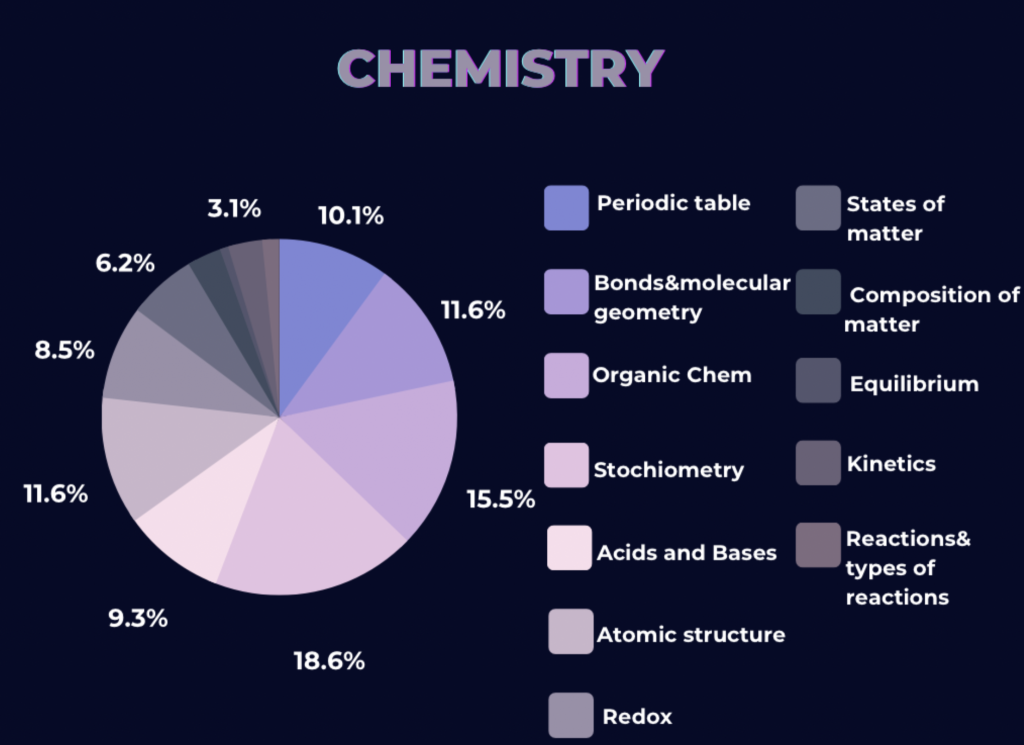

The chemistry section of IMAT 2021 was quite similar to previous years, covering topics like periodic table trends, chemical structures, bonding, and chemical reactions. However, this year’s test put more emphasis on the practical application of chemistry concepts rather than just memorization of abstract ideas. There were more questions that asked test-takers to analyze the chemical composition of substances or predict the outcome of reactions based on given information. Additionally, there were more questions on organic chemistry, requiring test-takers to identify functional groups ,recognize and understand organic molecules .
| Type of Question | Number of Questions |
|---|---|
| Kimetics | 2 |
| Chemical Bonding | 2 |
| Organic Chemistry | 2 |
| Reactions | 3 |
| Periodic table | 3 |
But, like any test, there were some traps that test-takers needed to be aware of. In the chemistry section, one common trap involved being asked to apply a concept in a way that it wasn’t meant to be applied. It was important to not just memorize formulas and rules, but to understand their underlying principles so that they could be applied properly. Additionally, test-takers needed to be cautious with units of measurement, as mixing them up or misinterpreting them could lead to incorrect answers.
Below is a breakdown of past paper topics in chemistry :
Math
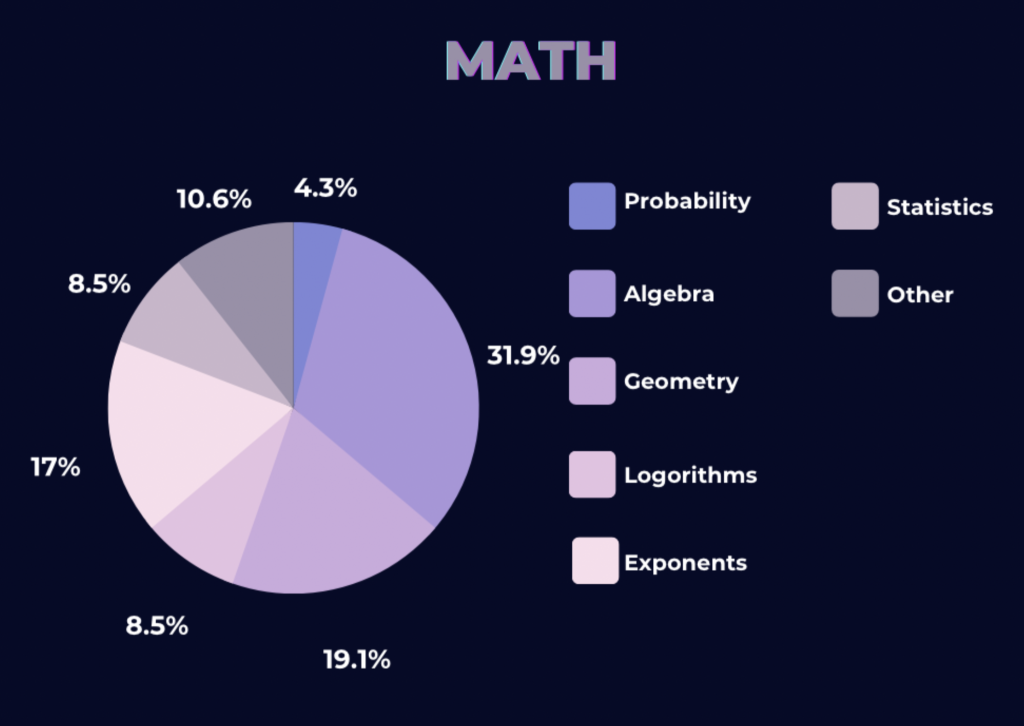

The math section of the IMAT 2021 exam placed particular emphasis on topics such as calculus, geometry, and algebraic manipulation. Candidates were required to apply these mathematical concepts , calculating the area of complex shapes or analyzing equations . Compared to previous years, the questions required a deeper understanding of the underlying principles and a greater ability to apply them to complex situations.
| Type of Question | Number of Questions |
|---|---|
| Algebra | 2 |
| Geometry | 2 |
Physics


Similarly, the physics section of the IMAT 2021 exam focused on topics such as mechanics, electricity and units and energy forms and transfer . Candidates were required to apply their knowledge of these principles. A common trap in the physics section involved mixing up units of measurement or misinterpreting the meaning of a given unit, requiring candidates to be vigilant in using the correct units and ensuring consistency in their calculations.
| Type of Question | Number of Questions |
|---|---|
| Mechanics | 1 |
| Pressure | 1 |
| Electricity | 2 |
In the math section, candidates were at risk of assuming that a particular formula or rule applied when it did not. To avoid this trap, candidates needed to be able to identify when a formula or rule was applicable and when to derive solutions using more basic principles. Overall, success on the math and physics sections of the IMAT 2021 required proficiency in interpreting data, graphs, and mathematical functions, as well as the ability to solve complex problems using mathematical and physical principles and good grasp and proficiency in calculus and quick calculation methods since the Imat does not permit calculators..For this section in particular, practice, practice, practice and improve the time it takes you to find patterns and solve calculations fast . This is of course important for the other sections but these in particular.
Physics and Math Sections
In conclusion, the IMAT 2021 exam had a strong emphasis on practical application of knowledge in all sections, including biology, chemistry, math, and physics. The test featured more complex and challenging questions that required test-takers to use critical thinking skills and reasoning to arrive at the correct answers. The traps used in the exam included complex phrasing, irrelevant information, and double negatives, making it essential for test-takers to read each question thoroughly and analyze its underlying logic.
Overall, the IMAT 2021 exam demonstrated a shift towards testing more than just the memorization of theoretical concepts. Instead, it placed a greater emphasis on problem-solving skills, analytical abilities, and the application of knowledge to real-world situations. As such, the exam provided a more comprehensive assessment of a test-taker’s aptitude and readiness for a career in the medical field.

